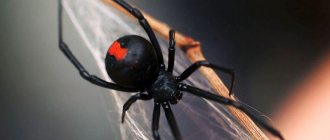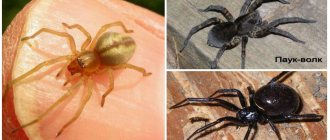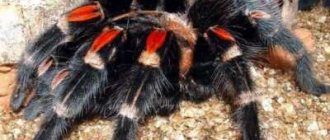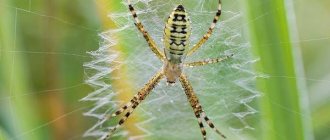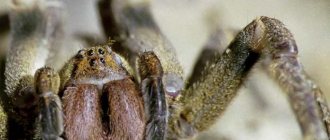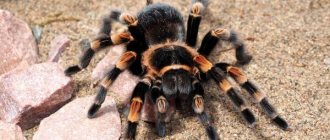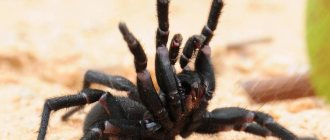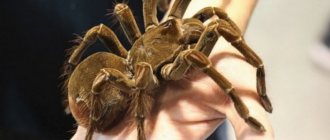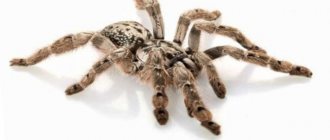17 August59770various animalskarakurtspidersdangerouspoisonous
Karakurt is a spider from the black widow family. There are many different dangerous animals on our planet. Everyone knows that a polar bear or a crocodile poses a huge danger to humans. But these predators are huge and will not go unnoticed. You should know that creatures that are difficult to notice can pose a much greater danger, because they are no larger in size than a five-ruble coin. One of these is the karakurt spider. In this article you will find a description and photo of the karakurt spider, and also learn a lot of new and interesting things about this spider from the genus of black widows.
What does karakurt look like?
Karakurt looks like a medium-sized spider. Karakurt females are significantly larger than males in size. The female karakurt grows 2 cm in size, while the male karakurt is only 0.7 cm in size.
Karakurt looks quite unusual. The karakurt spider has a black body, and on its abdomen it has red or orange spots of various shapes. Both male and female karakurt have this coloration. Sometimes there may be a white outline around the spots. Often, upon reaching maturity, the karakurt spider can acquire a completely black color without spots.
Where does the karakurt live?
Karakurt lives in Central Asia, Kyrgyzstan, Kazakhstan, Iran and Afghanistan, along the shores of the Mediterranean Sea, North Africa, southern Europe and Ukraine. In Russia, karakurt lives in the southern regions. The karakurt spider is especially common in the Astrakhan region, Krasnodar region and Crimea.
During particularly hot periods, this spider can migrate to the northern regions, but in such areas the karakurt lives only before the onset of winter. The most favorable living conditions for karakurt are those areas with hot summers and warm autumns. Karakurt lives in desert and steppe zones, wastelands, salt marshes, slopes of ravines and abandoned buildings.
Karakurt bite
The poison of the karakurt is quite strong, so a bite from a karakurt can be fatal. Fortunately, the karakurt attacks only if it is disturbed. Karakurt poison affects both animals and humans. The karakurt bite is not immediately noticeable and manifests itself within 10-15 minutes. During this time, the karakurt poison is already spreading throughout the body and the first signs of toxic poisoning begin to appear. Symptoms of a karakurt bite begin with a burning pain that spreads throughout the body. Typically, patients complain of severe pain in the chest, abdomen and lower back.
Also, a karakurt bite has the following symptoms: increased heart rate, shortness of breath, palpitations, dizziness, headache, trembling, vomiting, sweating, spasms in the bronchi and urinary retention. In the later stages of poisoning, a person begins to experience blackouts and delirium. Cases of death have been recorded in people and farm animals that were bitten by karakurt.
Experts say that people with strong immunity can more easily withstand a karakurt bite than those weakened by illness or those with allergies. It should be remembered that the highest concentration of venom in black widows occurs during the mating season and after laying eggs; in other seasons, bites are less terrible. Males, in principle, do not pose a danger, since they do not possess poison and, due to their small size, cannot bite through the skin.
To neutralize the effects of karakurt poison, anti-karakurt serum is used. Novocaine, calcium chloride and magnesium hydrogen sulfate are also administered intravenously, which give positive results. If it is impossible to get medical help, you should cauterize the karakurt bite with a burning match. But this must be done no later than 5 minutes after the bite. You can also cauterize the bite site with a hot metal object. Since the spider bites through the skin to a depth of only 0.5 mm, the heat destroys the venom that has not had time to be absorbed. But even after cauterization, you must seek medical help.
Livestock suffers from karakurt bites, especially camels and horses. These animals often die from karakurt poison. Once every 10 years, a mass reproduction of the karakurt spider occurs; during these years, livestock farming suffers large losses. Now karakurt is destroyed with the help of insecticides that are sprayed on the soil. Of course, the poison of the karakurt is not aimed at causing harm to humans or livestock, but serves the spider only to obtain food. Karakurt eats various beetles, flies, locusts, cicadas and grasshoppers.
Population and species status
According to scientists, karakurts are unlikely to be on the verge of extinction, since in some regions their numbers are at a fairly high level. In addition, changes in climatic conditions towards warming are expanding the habitat of such arthropods. They began to appear in areas where they had not previously been found, which poses a serious threat to human health and even life. In this regard, all medical institutions must be prepared to provide first aid to victims of a Black Widow bite.
There are regions where spiders are quite active, appearing in a person’s home, and also getting close to a person. In such cases, it is recommended to use various protective equipment. The Black Widow's venom is especially dangerous for children, the elderly, and people whose bodies are weakened in the fight against various ailments. It is permissible to fight such dangerous arthropods using any available means.
The bite of this spider is also dangerous because a person may not feel the moment of the bite, and after 15 minutes the negative consequences of the bite begin to appear. It is very important to provide the victim with timely medical assistance by administering anti-karakurt serum. Otherwise, the chances of recovery are minimal.
It should be noted that the karakurt will not attack a person just like that, much less be the first. He is able to bite only as a last resort, when the threat is very real.
Karakurt cubs
The karakurt spider is called a black widow, since the female karakurt kills her husband after mating. But the black widow of the karakurt will not much outlive the eaten spouse, because with the onset of cold weather the female dies.
Karakurts become capable of reproducing at the beginning of summer and begin migrating in search of partners. With the onset of heat (July-August), females and males of karakurt arrange temporary mating networks. After which the female karakurt looks for a secluded place to set up a den, where she can place cocoons with eggs.
Such places often become various depressions in the soil, abandoned rodent holes, as well as drainage of ventilation systems. At the entrance to the lair, she stretches a chaotically intertwined web. The female karakurt hangs 2-4 cocoons in the den, where they will survive the winter.
In April, the karakurt cubs will leave their cocoons. With the onset of summer, mature karakurt cubs will go in search of partners. Despite the fact that the karakurt spider is very prolific and has a very strong poison, it still has enemies in nature. The enemies of the karakurt spider are hedgehogs, wasps and riders. It is also common for karakurt eggs to be destroyed by herds of sheep and pigs, who simply trample them.
Don’t forget to subscribe to updates on our website and join us on social networks (Vkontakte, Odnoklassniki, Instagram) so you don’t miss anything and always stay up to date with all the news!
Don't forget to share with your friends!
Description of the spider
Name: Karakurt Lat.:
Latrodectus tredecimguttatusClass: Arachnida - Arachnida Order: Spiders - Araneae Family: Tenetiki - Theridiidae
| Habitats: | grass, ravines, fields |
| Dangerous for: | small insects |
| Attitude towards people: | bites, poisonous |
Are you afraid of spiders?
TerribleNo
The female karakurt is much larger than the male. Her body length can be from 7 to 20 mm, her partner’s is 4-7 mm. The abdomen is black; in young females it has 13 red spots bordered with white, but sometimes the spots may be absent.
On the underside of the abdomen, females have a red pattern, in the form of an hourglass, or two vertical stripes. The velvety body is covered with forked hairs.
The male differs from the female not only in size, but sometimes his body can be black with a brownish tint and white spots. The animal has 4 pairs of black legs, they are long and strong.
Spreading
The Karakurt spider lives in Southern Europe, Northern parts of Africa and Asia. In Russia, it is found in territories from the European part to the southern regions of Siberia.
Its favorite habitats are grassy areas, meadows, arable lands and open dry areas. It is found in sheds, vegetable gardens and even in people's homes. Karakurt can be seen on rocky and sandy shores.
The number of individuals of this species differs from year to year, but at intervals of 10-12 or 25 years there is a surge in the number of arthropods.
Lifestyle and reproduction
The spider weaves its webs on the ground, the hunting threads are stretched in different directions, and on top, above them, in the shape of a key, a shelter is made in which it stays at night. Usually the karakurt makes a web in the grass or between stones.
In the laboratory, spiders appear on day 49; in nature, this period lasts a little longer. Karakurt eggs are toxic, like other spiders of this species.
Preparation
The female migrates in May-June, finds a secluded place and makes temporary mating nets, and the sexually mature male looks for her. Once caught in the web, the male never leaves it.
Pairing
After the last molt, the female becomes sexually mature, the male binds her with a web and mates with her. After this, the female is quickly released from captivity and eats the male.
Masonry
After mating, she makes a lair, weaves up to 5 cocoons, in each of them she lays from 100 to 700 eggs and hangs them in her home. At first, the cocoons are white or cream-colored, then, closer to the appearance of the offspring, they become yellow.
Birth of cubs
Young individuals appear in April and are carried by the wind with cobwebs. Before becoming sexually mature adults, they go through several stages of molting, females - 8 times, males - 4-5 times.
Lifespan
Females live until November, their lifespan is approximately 302 days, males die in September, their lifespan is about 180 days.


